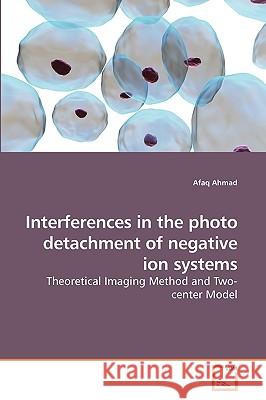Interferences in the photo detachment of negative ion systems » książka
Interferences in the photo detachment of negative ion systems
ISBN-13: 9783639255805 / Angielski / Miękka / 2010 / 128 str.
Interferences in the photo detachment of negative ion systems
ISBN-13: 9783639255805 / Angielski / Miękka / 2010 / 128 str.
(netto: 251,93 VAT: 5%)
Najniższa cena z 30 dni: 264,53 zł
ok. 10-14 dni roboczych
Bez gwarancji dostawy przed świętami
Darmowa dostawa!
The purpose of this book is to understand the interferences in total and differential photo detachment cross sections of negative ions with and without the presence of a reflecting wall. photodetachment is a process in which a laser photon detaches an electron from a negative ion. This detached-electron then goes into an outgoing wave and the wave propagates away from the ion core. Far from the ion core, the wave propagates according to semiclassical mechanics, and it is correlated with classical trajectories. The wave fronts are perpendicular to the trajectories, and the waves propagate along the trajectories. For photodetachment of H near a re ecting wall, the waves initially propagating away from ion core are turned back by the re ecting wall, which then interfere with waves initially propagating in that direction, giving rise to a two-path interference pattern on a screen. The two-path interference of detached-electron waves can be used to infer the distance between source and wall and the bound length of a diatomic molecule. The interference fringes are indeed possible in view of the experiments on photo-detachment microscopy.""
The purpose of this book is to understand the interferences in total and differential photo detachment cross sections of negative ions with and without the presence of a reflecting wall. photodetachment is a process in which a laser photon detaches an electron from a negative ion. This detached-electron then goes into an outgoing wave and the wave propagates away from the ion core. Far from the ion core, the wave propagates according to semiclassical mechanics, and it is correlated with classical trajectories. The wave fronts are perpendicular to the trajectories, and the waves propagate along the trajectories. For photodetachment of H− near a reflecting wall, the waves initially propagating away from ion core are turned back by the reflecting wall, which then interfere with waves initially propagating in that direction, giving rise to a two-path interference pattern on a screen. The two-path interference of detached-electron waves can be used to infer the distance between source and wall and the bound length of a diatomic molecule. The interference fringes are indeed possible in view of the experiments on photo-detachment microscopy".











